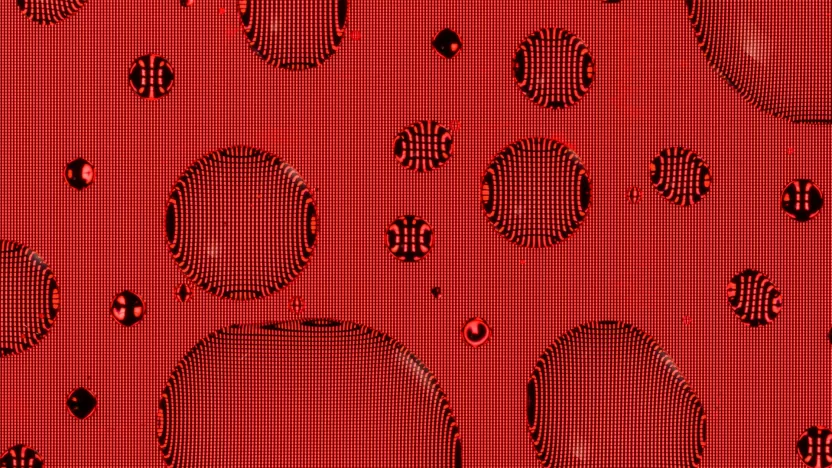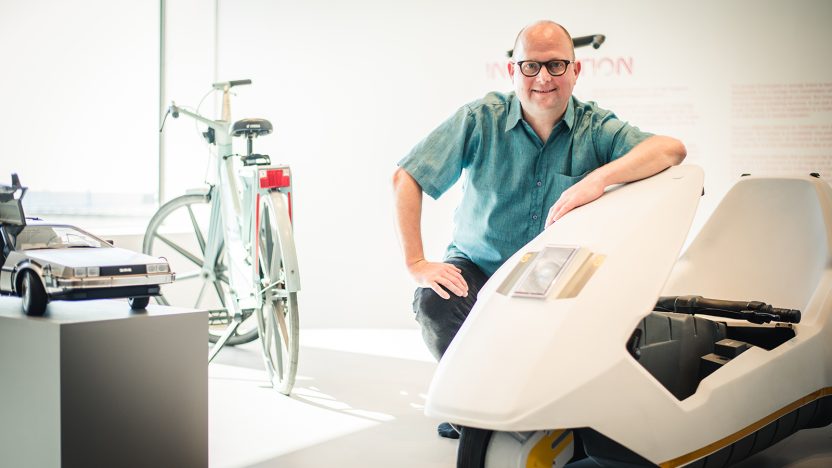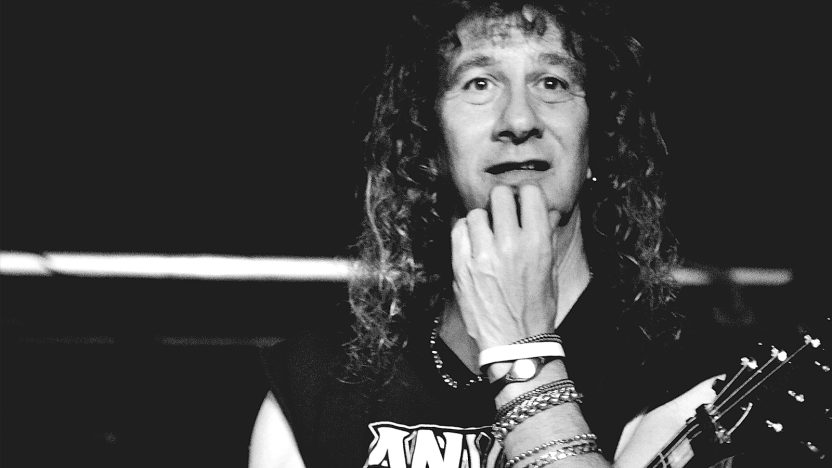Paolo Cirio
Investigating social fields impacted by the internet, through art, as technology changes how we perceive the world.
by Eleonora Raspi
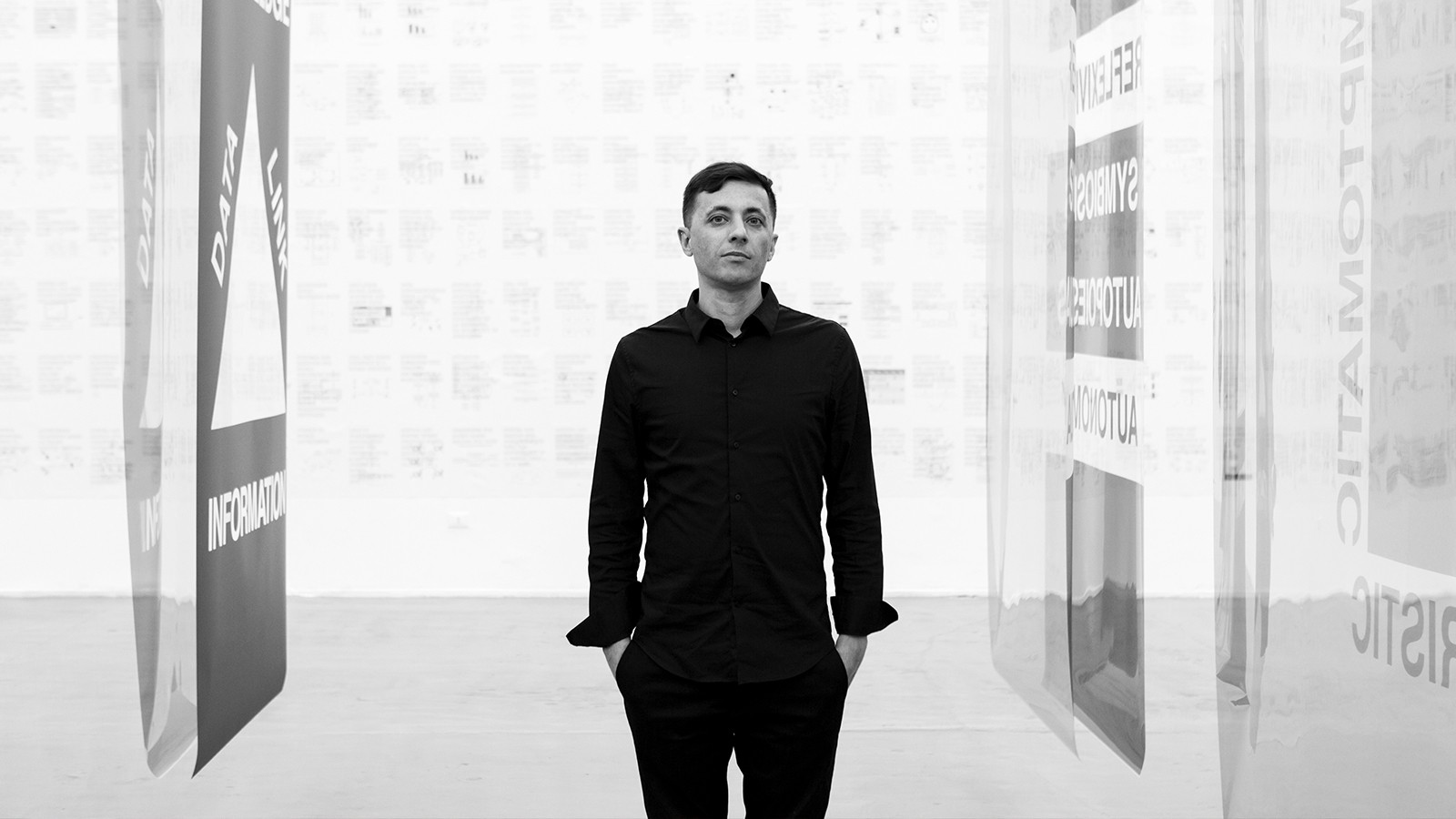
Paolo Cirio is an artist who works among the legal, economic, and cultural systems of our information society. He shows his research and intervention-based works through artifacts, photos, installations, videos, and public art. He has exhibited in museums globally and has won prestigious art awards. His artworks have been covered by hundreds of media outlets worldwide and he regularly gives public lectures and workshops at leading universities.
Your work deals with pivotal issues such as appropriation, control, image rights, and information theory. How did it all begin?
I was interested in media studies and the power of media. As an Italian of my generation, I was influenced by Italian philosophers, like Umberto Eco, and studies in semiotics, media language, and communication. Moreover, in the mid-’90s, during Silvio Berlusconi’s rise to power, the Italian media and political landscape started to become extremely fascinating. This also corresponded to a time when the Internet publicly came along — as a small and new thing — yet no one was using it or was even able to access it. Somehow, I started to be interested in that, with the feeling that this could soon become the new medium that was going to replace everything before it.
Eventually, the Internet became more and more crucial in everyday life and, since my work is dealing with the philosophical and social implications of the medium, I began to tackle new and different issues such as finance, advertising, and social media.
Now, I feel the Internet has changed society to the point of having become its true core, and to some extent it has become society itself. For this reason, I argue that I am not working with the Internet, but rather with society.
How does your work intersect with society?
In working with the Internet, I work directly with the one thing that affects society the most, and with what society looks at: For example, political elections, economy, perception of reality, our culture and communication are all strongly informed by the Internet. In this sense, my work is also about dilemmas and conflicts that society has to face because of the Internet. Look at what’s happening now with the U.S. presidential impeachment, or the slightly different take on social control in India, or China.
The 1970 milestone exhibition Information at MOMA comes to mind. Are there any parallels between now and then, culturally and socially speaking?
This sounds like a big jump because people tend to think about the future instead of the past. However, looking closely, you realize that the interesting moment we are living in already happened, in a different form, 50 years ago. When the two shows Information and Software were presented in New York, people talked about the same issues: how information technology was affecting society. It was the first time information technology, and especially computers and networks, were starting to impact the economy, politics, and social life. Artists started to look at all of this, generating a wave of conceptual art, system art, and a perspective that was looking at I.T. as a political tool ready to be transformed into an aesthetic object. So there are some parallels, and although with time technology has changed everything, and then has kind of lived a life of its own for a while, we are now in a moment when technology is heavily politicizing and affecting society again.
The curator of the Information exhibition argued that at the time the project “was essential for an art institution dealing with artists who broaden artistic definitions and challenge our perceptions.” You, 50 years later, address art history as a system with your exhibit System of Systems in Turin. Do you feel like you’re stretching boundaries?
Many of my projects tackle contemporary matters and, in a way, have a pop dimension, but at the same time, I am always trying to contextualize these works within an aesthetic and philosophical landscape. I spent a long time researching, writing, and reading philosophy and art history to articulate the issues I really want to discuss. My recent exhibition at the Giorgio Persano Galleria in Turin — the first gallery presenting Conceptual Art and Arte Povera in the ‘60s and ‘70s worldwide — is continuing such a trajectory, but with today’s materials and systems that are more powerful and broader than in the past, as they impact our society on a global scale.
It is interesting to look at how the history of the medium (the network and computation itself), did not start with the Internet, but rather it ran through phases to get there. After all, the Internet has a 20-year history and is constantly evolving.
To what extent is data real and how is this data shaped and seen?
There is a kind of mutual relation between the medium and society. Data has immense power, but that power becomes real and material only when people use it and make that same data seen and shaped in different forms. Society decides how to use that data, whether to manipulate it, change it, misread it, or use it in the worst or best way possible.
What is your approach to data? And what’s the role of social manipulation in your practice?
In a way, data is matter: it takes different forms; these forms offer different interpretations depending on the audience, as with any other piece of art. However, data, and the Internet, are a unique kind of matter, as it affects millions of people, governments, economy, society, and social fields directly. In my work, I take data, re-shape it, and present it as a new sculpture that eventually has an impact on all those social enterprises that are doing business with that data. At the moment of publicly presenting such new forms, I usually receive reactions from big companies, from thousands of people or from the media, creating ripple effects. Sometimes — especially when my artwork becomes viral and global — people’s interactions with it produces even more artistic outcomes, as a performance. This happened, for instance, with a few projects, particularly those dealing with big data, like Face to Facebook and Obscurity and Loophole for All. People started to see things differently: that’s the role of art, after all.

We might think that the more data we have, the easier it is to find our path to truth. But we discovered it’s actually the opposite: Data seems to be moving us away from the truth. Is post-truth a dystopia? Can the same data/technology get us back on track?
In my work, I generally look at utopian and dystopian realities of the Internet and thus at the contradictions and limits of ethics. However, at the same time, to me, they are not narrations or slogans: I do really want to break those down. My goal is to crack the complexity and the general understanding of things by offering more insights into complex issues, such as post-truth. By doing that, I sometimes identify solutions that may fix the problems that I encounter. This is the hacker attitude that breaks very complex systems/networks, finds the problem and the bug, exploits it, creates chaos, and eventually offers a way through. But it’s beyond the technological apparatus, the paywall or the firewall:, it concerns a society that deeply reflects technology. In some of my projects, like Global Direct, this utopian approach is evident, as it shows the unused potential of the Internet; in Sociality, both utopian and dystopian issues are addressed. In Loophole For All I even discuss how offshore finance could be fixed.
Would you say that you are trying to expand common awareness of the issues related to data and the Internet?
Yes, and some of my projects have become activist campaigns. With Obscurity, for example, for three years I have worked to create a privacy policy in the United States for the “right to be forgotten,” with the help of lawyers and legislators to promote it. With a similar approach, with Sociality, I am working on the idea that some technology should be legislated, or banned completely. However, these are not easy issues to solve as long as corporations, governments, politicians, and users try to control them.
The Internet is becoming a place of conflict because of the power of the tool — and everyone wants to control it. An issue such as post-truth could ideally be resolved in many ways, but it just won’t be. There is no will to solve it. This is for me the real utopia: it’s not about having global peace, it’s about solving simple problems. Nevertheless, the idea of utopia is constantly changing: error after error, we are trying to fix our mistakes. And for me, it is all good, because we are finally facing our problems. Take the matter of privacy: I’ve been working and researching privacy surveillance since the ‘90s, and back then, no one cared about it, until we discovered we were all mass surveilled. After that, new tools were introduced to prevent it. It’s still not perfect, but it’s getting better.
In such a context, what is the artist’s role in society? Do you see your work as having an impact on people’s awareness of the world that they live in?
Absolutely. The artist’s work is probably more symbolic now, than ever, and because of that, it inspires and shows people something that they couldn’t see before, like societal contradictions or the way things are re-shaped. Indeed, I believe the artist can change society, not like a politician would, but rather at a cultural level, and that eventually has a ripple effect on other fields. I have been producing a few projects that have been influential, for instance, Loophole For All was done before The Panama Papers and other financial leaks, and the data that the work revealed was used by several journalists for further investigations. And when I presented Face to Facebook (2011), Facebook was not perceived as it is today: People were excited about it and now, after all the recent scandals, most people are leaving Facebook. Then, with Obscurity, I was one of the first to talk about the “right to be forgotten” in the United States. People didn’t even know of such a concept at the time, but the project slowly started to reshape public conversation. So, there is a degree of impact, which may just assume the form of inspiring or changing perspective or focus.
In many of your works, you question and cross the thin line of privacy. What does this mean as an artist, thief, or visionary?
Since data is the material I use in my artistic practice, a substantial part of my art is about appropriation. There’s a fine line between appropriation and embezzlement. This is almost a Readymade, an object assembled with data that people can see on their screen, now in a whole other context with another meaning, or presented in a different configuration. But still, differently from appropriation, in Readymade, the process of transformation (of data) is much more sophisticated, as there are millions of records about people or companies that I have to remodulate in other forms. Most of the data that I show is often public and already compromised, but because I do discuss the politics of data, I am also careful with the ethics of representing it. I try to question myself, too, to be aware of the sensitivity of the material that I show, which sometimes presents difficult ethical decisions that I have to make. In some cases, I deliberately decide to blur the data or not expose it at all: for instance, I do not show clear names next to a picture and I do not index data on Google. I carefully choose how to show the information that I’m taking, to achieve specific goals, whether they are political, aesthetic, or performative.
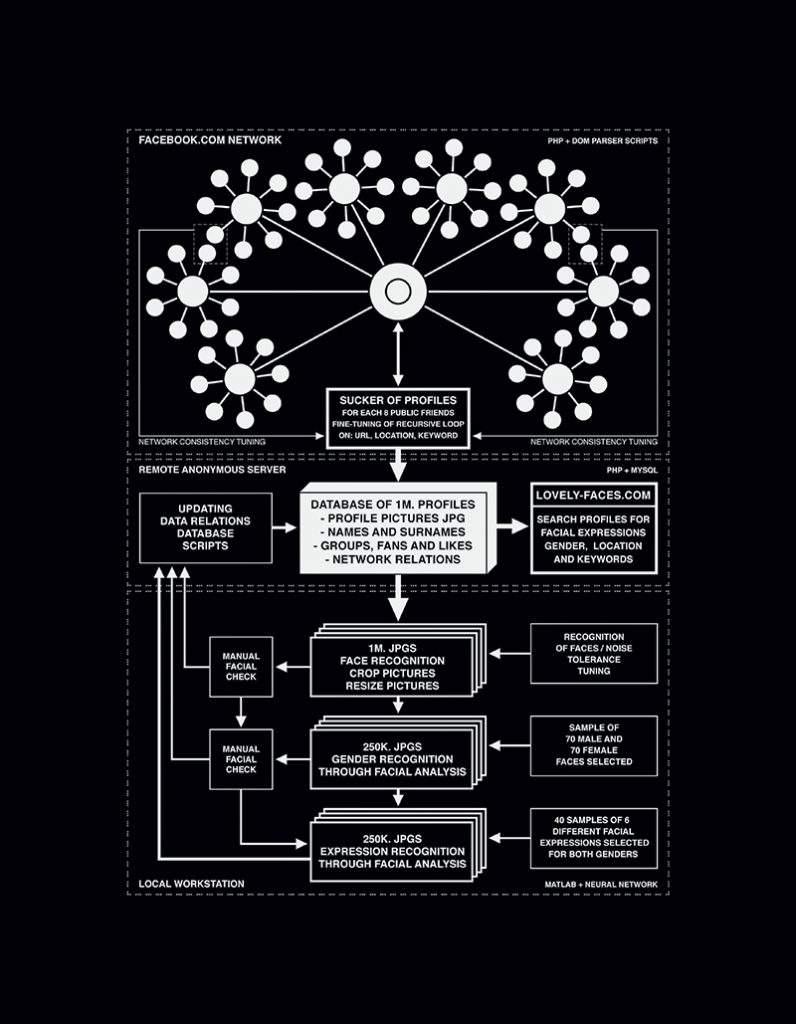
How have you addressed the ethics of the information that you collect?
I have extensively been addressing the issue of ethics in my work, as it has become a contingent issue of the Internet in recent years. Somehow, it concerns the essence of the medium itself, and I find it very interesting for two reasons: First, the “aesthetics of the ethics,” in other words, how ethics can produce aesthetic meaning. The second reason concerns the philosophical and political side of ethics, and how the Internet is becoming an almost philosophical dilemma. When we discuss ethics, there are difficult questions that need to be addressed and many compromises that need to be made to answer those questions. With information technology, we constantly face the dilemma of whether to expose or not expose information, thus compromising the potential of that particular, powerful information. And this is not going to be resolved anytime soon. Still, it’s interesting that we are facing it, because the Internet emerges not only as a technological fun space where we share everything, but as a place where we have to tackle human dilemmas.
In 1985, director Michelangelo Antonioni argued that matter would become an impalpable idea. Is the media leading us in that direction?
There are material effects and outcomes, literally physical things, that are affected by virtual space; I don’t think there is one place that’s completely virtual, or a place that is completely physical. Rather, I think there is a hybrid environment that is constantly changing, interdependent from the two places. For instance, Street Ghosts, shows how we navigate among an urban space and what we see on screen while we use maps: in particular, here, it becomes clear to what extent a virtual map might change and have an impact on urban space. Take the Airbnb website, and how the places, the offerings, and the listings within a neighborhood, will eventually transform the neighborhood. This applies to other situations, like how Amazon is changing the manufacturing and distribution process, how transportation systems and infrastructure are changing according to the Internet, and vice versa. We are learning that humanity cannot be reduced to technology, and technology cannot replace some complex human processes, because we are still led by intricate philosophical questions. The same goes for physical reality: it can not disappear, at least not for a long time.
What are, in your opinion, the crucial utopias that we should aim for as a society?
It is hard to talk about the future these days, but I can say what the crucial utopias will probably be. Perhaps a democratic form of government, and the agency to face and solve global issues that are not yet tackled in the right way. This would be a sort of UN, but one that is more democratic and with more enforcing power to address those issues, one that is opposing the contemporary powerful actors who are reshaping the global political scene and forms of communication. Although some issues, like climate change, are tackled in some countries, it isn’t enough. Moreover, we would need a better privacy policy within the Internet; better economic agreements. Those are all the same problem and everyone is affected.
